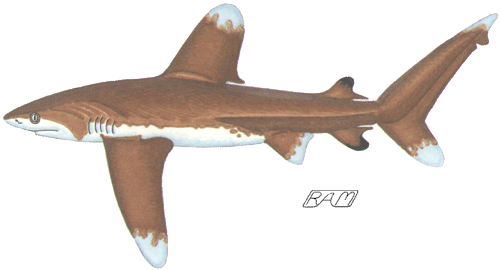The Nose Knows

Oceanic Whitetip Shark (Carcharhinus
longimanus)
What is mechanism that allows a shark to smell blood at great distances in the water?
J. Blackie
Actually, sharks cannot smell anything from a great distance. What they can do phenomenally well is sense extremely minute quantities of dissolved chemical 1,300 feet (400 metres) or more from their source. But, before it can be detected as a 'smell', a tiny sample of that chemical must come into direct contact with specialized chemically-sensitive tissue known as 'olfactory epithelium'.
Here's how it works. In sharks, the chemically-sensitive tissue of the nares is contained within a pair of capsules that open to the sea about mid-way along the undersurface of the snout. The flow of scent-bearing water into and out of these capsules is controlled by a flap of skin. Within each of these capsules, the actual olfactory epithelium is packed into a roughly spherical organ composed of a series of closely-spaced plates called 'Schneiderian folds'. These plates serve to greatly increase the surface area of chemically-sensitive tissue within a relatively small, compact space.
As the shark swims, water flows over the olfactory epithelium and brings minute samples of dissolved chemicals into direct contact with the olfactory epithelium. A variety of chemically-sensitive receptor cells respond to a wide range of dissolved chemicals, but each functions in essentially the same way. Each chemical has its own distinctive shape, which fits snugly into the appropriate receptor cell — much like a key in a lock. This, in turn, stimulates an electrical change in the receptor cell. The more tightly the sample of dissolved chemical fits into the receptor cell, the stronger its electrical response. This electrical response is passed from sensory nerve cells to the spinal chord and on to the brain, where the signal is interpreted as a 'smell'.
Dissolved chemicals dissipate very rapidly in the sea, so that — even a relatively short distance from their source — they can be extremely dilute and thus very difficult to detect. When tracking down the source of an attractive odor in the open sea, a shark follows several strategies. The simplest is that, whenever an attractive chemical is sensed, the shark turns into the prevailing current. Any dissolved chemical spreads out from its source in a conical 'odor corridor' in the general direction of the prevailing current. By turning into the current whenever it senses an attractive chemical, sooner-or-later this strategy will bring the shark closer to its source.
The sensitivity of sharks to water-borne chemicals is often so acute, they can actually distinguish which nare — the left or the right — is receiving the stronger whiff! Thus, by comparing the strength of a chemical signal between its two nares, a shark can quickly home in on the source of an attractive odor. In hammerhead sharks, the nares are located near the tips of the hammer and may be separated by a metre or more. Special grooves along the leading edge of the hammer help channel scent-bearing water to the nares. As a result, in warm waters, hammerheads are often among the first sharks to arrive where fish scraps have been thrown overboard.
And lastly, certain chemicals — such as volatile oils — often indicate a rich food source and can be rapidly carried long distances by wind. A recent Russian study has demonstrated that the Schneiderian folds of at least one shark species, the Oceanic Whitetip (Carcharhinus longimanus), are spaced in such away that they can capture air bubbles at the surface. The ability to sample the air chemically may enable these sharks to locate the source of an attractive odor more quickly than species which cannot. This would give the Oceanic Whitetip a major competitive advantage over other sharks in the otherwise featureless expanse of the open sea.
Raising its sensitive nares above the surface, this Oceanic Whitetip (Carcharhinus longimanus) may be sampling the air for volatile chemicals that could indicate a floating carcass.
Photo © David Fleetham david@davidfleetham.com; used with the gracious permission of the photographer.

